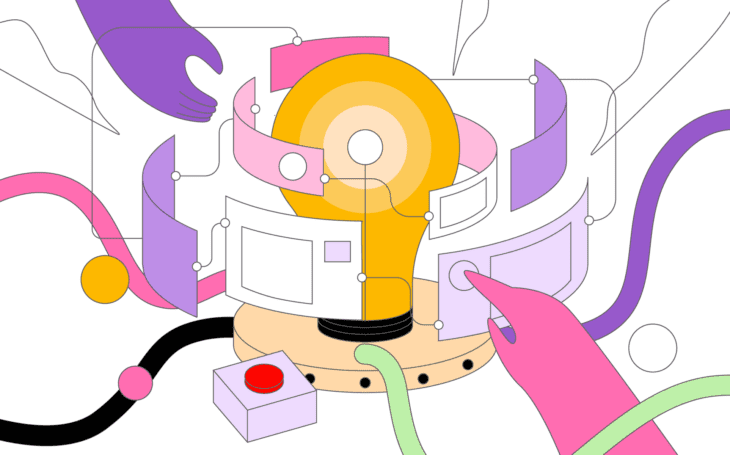🎁 Free 30-day publishing fees on Pay-As-You-GO. Get 15% off when recruiting from the UserQ Panel, with code HELLO15

Ready to validate your prototype with our easy-to-use prototype testing tool? Well, we’ve got some must-hear advice and support to make the whole process easier and quicker – with no mistakes to make.
Below you’ll find answers to FAQs we’re asked pretty much every day by hard-working researchers, like you. So take a read and hopefully they’ll clarify any queries or concerns you have about testing a prototype with flying colours.
Getting started: why and when you should carry out prototype testing
“What is the purpose of prototype testing?”
There are two main purposes…
One: to make sure you’ve built the right product for your audience. Our prototype test tool is a vital part of your evaluative research – ensuring your digital product is fully optimised and solves the problem or pain point that your target users is experiencing.
The second purpose is more of a tactical one: to discover any usability issues. In other words, a prototype test helps identify issues with your current design, ie. whether your website’s interface is confusing for someone to use, if they’re able to navigate it properly, and if the site architecture flows nicely.
Once you’ve uncovered the usability issues and the user frustrations of experiencing the prototype, you can then make tactical changes and improvements to the design, based on the appropriate feedback you’ve been given.
“How will prototype testing help me?”
One thing that UX designers should never forget: they’re not the user. No matter how many years of experience you have, and no matter how many interfaces you’ve built, prototype testing works wonders with its capability to uncover something new and different about a product that you might not have been aware of.
Remember…there are endless types of target audiences out there with different needs, requirements, and standards. Testing a prototype allows you to uncover the users’ expectations to ensure you meet them (or preferably excel past them).
Our UserQ prototype tests are also specially built so you can ask participants specific questions. In addition to creating task flows, you can gain subjective feedback and qualitative opinions on what users think and feel about your prototype design – allowing you to eliminate the issues and frustrations experienced when they’re using it.
“Can UserQ help me to test my prototype?”
Absolutely. As long as you have a Figma prototype in a mobile, desktop, or tablet form. Our UserQ platform allows you to set up either a task flow prototype test or a free flow prototype test.
A task flow test helps you track user behaviour as testers complete a specific task. This provides important information like the average time spent on a page or on a flow, the average number of clicks, and heatmaps/clickmaps showing areas of focus on a single page.
A free flow test allows participants to freely explore your prototype based on the instructions you provide, allowing you to gain valuable feedback about their experience by also asking specific questions during their journey.
Check out our full guide for more information on how to create a prototype test using the UserQ platform. It’s an easy-to-understand step-by-step tutorial written especially for researchers, like you, in mind.
The prices of carrying out a prototype test are as follows:
- $10 (if you share the test with your own panel)
- $6 per participant (if you use our UserQ panel).
Good timings: FAQs on prototype testing in the design timeline
“When is the best time to test a prototype?”
As early on as possible. The earlier you test a prototype, the more time you have to uncover issues that you can retest again and again until the issue is solved.
Take a read of our full remote testing blog to understand more about what testing method to use along the design process. What remote research methodology is best to use and when all depends on the objective you’re trying to solve.
“How advanced should my prototype be for testing?”
To gain valuable insights and worthy feedback, we recommend having a prototype to be of a mid to high-fidelity. That way the users have a real perception of the end product – meaning you’ll obtain realistic and consistent data.
Testing a low-fidelity prototype runs the risk of further confusion with users not understanding the functionality and purpose of your design. You can technically test paper prototypes or digital greyscale boxes, but it would be more of a test for the flow of the site itself, rather than the design as a whole, that properly represents the end product.
“How often should I conduct prototype testing?”
Our experts suggest testing products until you know you’ve eliminated at least 90% of all usability issues – or until you know people are able to complete their tasks efficiently ,and they’re not confused about anything.
Ultimately the answer also depends on how far along the design journey you are and whether the prototype is already based on existing products. If you’ve created a brand-new product, we recommend retesting a prototype after every major iteration to ensure there are no recurring usability issues.
Whether or not you should retest also depends on the types of changes you’ve made – big or small. While retesting may not be necessary for small changes (like minor copy revisions or colour alterations), we would recommend retesting for big functionality changes such as page reordering or replacements of buttons/labels, ie. anything that affects the way people use your site or product.
Perfect participants: FAQs on who should take your prototype test
“How many people should I test my prototype with?”
We recommend a minimum of five participants per test, but a more substantial number of around 25 to 30 will bring the best, most reliable results.
Check out our full blog for more information on sample size.
“Who should I test my prototype with?”
Ideally, prototype testing should be carried out on representatives from your target audience i.e the potential users of your product according to a target age, gender, location, psychographics etc. Using a representative sample of the people who will actually use your product helps you identify the specific needs and requirements of your target audience in much more detail. For example, if you’re a new luxury hospitality business opening in Dubai, it might be best to test your prototype on users living in the UAE with a high income.
However, if you’re constrained by budgets and timings, you can choose to test with your family, friends or colleagues – even make a hallway prototype test (a type of test that involves grabbing random passers-by). Just beware that such loose and quickfire tests might not uncover true valuable data nor provide a deeper understanding of your functionality and features.
To validate a prototype with people who’ll actually be using your product, we recommend recruiting from our UserQ panel. From a pool of over 10,000 testers around the world, you’ll get real market-specific insights based on precise demographics ranging from age to language to digital proficiency.
Learn more about how much our panel recruitment costs and use our credit calculator here. We provide accurate pricing in just a few clicks.
General advice: other FAQs
“Does my prototype have to be in Figma?”
“How many journeys can I test in one UserQ test?”
Depending on what type of prototype test you build (either task flow or free flow), you can test a total of five different journeys for each one of the tests that you publish.
For task flow tests, you can also add one follow-up question for each of the tasks. And for free flow tests, you can add up to three questions per flow.
“What advice would you give a researcher like me using UserQ prototype testing for the first time?”
We have three key pieces of advice every researcher needs to know…
1. Read our guides!
We’ve written complete step-by-step tutorials for each of our test types (including prototype testing), covering everything from how to create a prototype test to how to analyse the results. Our guides are super helpful for making sure you’ve set up the test correctly – ensuring you’ve created a seamless test experience for your participants too.
You can explore our guides here.
2. Prepare your Figma file correctly
Make sure the design includes everything it needs. Optimise the prototype design file so it flows nicely and doesn’t slow down the rest of the test or confuse participants. Our best tips for optimising the file include: eliminating password protections, compressing images, simplifying custom fonts, and removing any irrelevant pages and frames.
3. Word your tasks concisely
The more context you provide in the tasks and labels, the better the answers they give. We recommend wording the tasks in a hypothetical situation that gets people thinking. Let’s say you’re an online bookstore creating a prototype test to see how easy it is to find certain novel genres on your website, you could ask: “You’re buying a birthday present for a friend who loves horror, where would you find gothic fiction?”
But that’s not all. We’ve plenty of other helpful advice on our best practices blog. Take a read of our top tips and tricks for utilising our user research tools in the most efficient way possible.
“Are there any changes coming to the current prototype test feature?”
Right now, you can only test using Figma because it’s the most popular prototype-building tool out there. However, we’re also looking into introducing other compatible tools and features such as live tests and unmoderated testing – allowing users to browse your prototypes and speak out loud. That way researchers, like you, can gain deeper insights into how users think and feel about your prototype in real-time, as they’re using your product.
Follow us on Instagram, LinkedIn, or YouTube to know what’s coming down the line and to keep up-to-date with all the goings on here at UserQ.
Ready to build your prototype test?
Check out our full prototype methodology page for more information on how prototype testing can help you and when to use one. Whenever you’re ready to start testing, sign up as a researcher and create your account for free – with no monthly commitments.
Related Post

The benefits of user research
User research is typically a key part of product development and business growth all around the world, but here at

Best practices for conducting remote
In this guide, we’ll let you in on UserQ’s top tips and tricks to utilise our selection of remote user

Start, Grow, Lead: A Guide
A career in which you can make a real difference to the everyday lives of customers and clients alike is
Subscribe to our
product newsletter!
Receive emails about UserQ updates, new features,
offers and latest trends.


